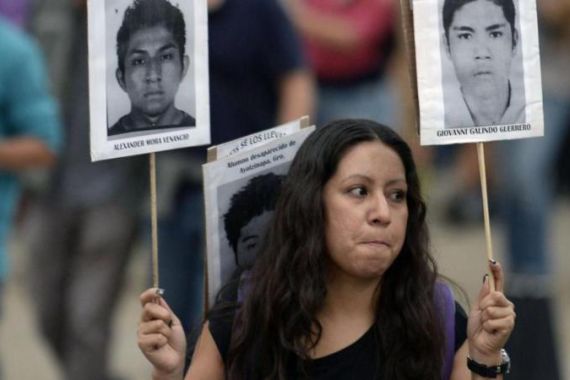How citizens lead the search for Mexico’s disappeared
Relatives of the disappeared in Mexico create the first independent forensic and DNA database to sea

We are convinced that the greatest revolution in forensic science and human rights is happening in Mexico. This revolution is in the hands of relatives of disappeared persons, who silently, but consistently, have embodied a new form of scientific and political citizenship. People working in factories, office jobs or dedicated to commerce who used to be apolitical have become active agents of change due to the disappearance of a loved person.
This “awakening” (as many relatives describe it) can be exemplified by Letty “Roy Rivera” Hidalgo, mother of two and former teacher, that after the abduction of Roy Rivera from her own house in Monterrey Nuevo Leon, has become one of the most active leaders in the search for the disappeared in Mexico. The transformation of Letty started after waiting for months for police officers to do their job.
Keep reading
list of 4 itemsGeorgia’s president vetoes controversial ‘foreign agents’ bill
‘Regime machinery operating efficiently’ as Tunisia cracks down on dissent
Why Egypt backed South Africa’s genocide case against Israel in the ICJ
In the face of their dereliction of duty, Letty started her own search for truth. Armed with basic knowledge of computer systems, Letty learnt how to trace the calls that were made from the mobile phone that her son was carrying that day. After a couple of days she managed to find sixteen locations from where the mobile phone of her son had been calling.
She even took photos of these houses and took the evidence to the pertinent local authority. Then, she insisted for weeks to the local authorities in Nuevo Leon, who finally decided to visit one of the locations she gave them. Inside, they found three persons who had just been kidnapped; along with guns and members of organised crime. Nonetheless her son was nowhere to be seen.
|
|
| Families of missing Mexico youth seek answers |
Regardless of her success in locating the so called “security houses” (places in which kidnapped people are kept), the authorities decided to dismiss her petitions to look into the other possible locations. Four years on and she is still looking for her son. But now, she does the same for hundreds of people who have disappeared in Mexico through FUNDENL, the organisation that she leads.
Together with other relatives of disappeared persons in Monterrey, Nuevo Leon, Letty has been fundamental in organising effective opposition to “governmental truths”, including the first ever citizen-led exhumation in 2014, supported by the Team of Peruvian Forensic Anthropologists and the recently created Citizen-Led Forensics (or Ciencia Forense Ciudadana in Spanish) , and its partner organisation Gobernanza Forense Ciudadana.
Letty is just one of the sixteen members that today, are part of Citizen-Led Forensics, an ESRC (Economic and Social Research Council, UK) sponsored project based at Durham University that aims to transform the relationship between science and its “publics” as we know it. The idea for this project was born in 2011 while living in Colombia and doing an ethnographic research on forensic science. It was then where we thought of a new model to make the right to the truth a reality.
Our feasibility study, carried out during 2013 was possible thanks to the support we received when Arely won the Global Impact Competition of Singularity University in 2012. The idea was to analyse the possibility that relatives of the disappeared could govern technologies usually controlled by “experts” to find the truth about the whereabouts of their loved ones. By the time we finished this first ethnographic study, Mexico had almost reached half of the death toll, and approximately half the number of disappeared persons that Colombia reached in 50 years of violent conflict.
The innovation at the heart of Citizen-Led Forensics is simple. Along with relatives of disappeared persons we have created a budding forensic system in which tools such as DNA and forensic databases are public goods, governed by people that have become forensic experts in their own right, while searching for their loved ones. We are convinced this project is a game changer because it breaks the monopoly of truth of the State.
According to Human Rights Watch and the Mexican Commission of Human Rights, since 2006 there have been approximately 27,000 disappeared persons in Mexico and the numbers are still rising. Even more, none of these numbers count the thousands of migrants that have disappeared in their transit through Mexico.
In Citizen-Led Forensics we believe that “the path of the one is the path of the many”. That is why we need to create a transparent national database. We cannot keep searching for the disappeared 43 at a time. The revolution in human rights and forensic science we are envisioning cannot be possible if we do not start changing the rules of the game one by one. This means that we have to break in the pristine spaces, reserved for scientific experts and bring the public forum back to forensic science. Thus we say, rephrasing Bruno Latour: “Let us into your laboratories and we will change the world.”
Ernesto Schwartz-Marin holds a PhD in Genetics in Society from University of Exeter, UK. He is an International Junior Research Fellow in the Department of Anthropology at Durham University and the Principal Investigator of the ESRC Transformative Project Citizen-Led Forensics. Since 2012 he acts as the Chief Innovation Officer at Gobernanza Forense Ciudadana.
Arely Cruz-Santiago is a Doctoral Researcher based at Durham University, Department of Geography. She holds an MSc in Criminology and Criminal Justice from the same university and a BA in International Relations from the National Autonomous University of Mexico, UNAM. She is the Co-Investigator of the ESRC Transformative Project Citizen-Led Forensics. Since 2012 she is president of the Mexican NGO Gobernanza Forense Ciudadana.